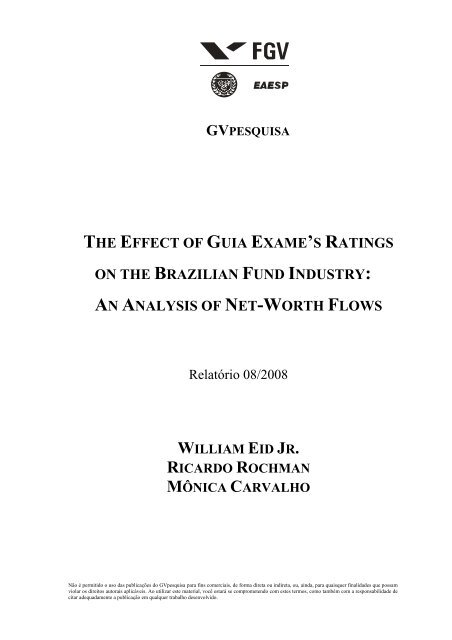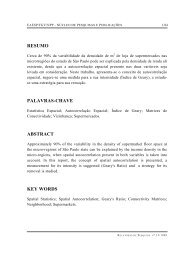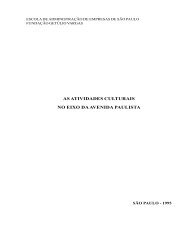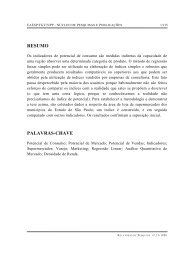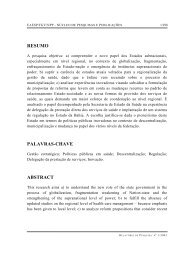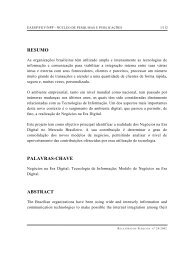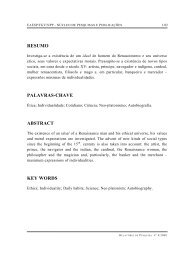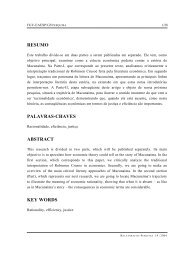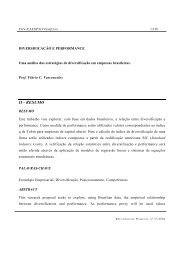THE EFFECT OF GUIA EXAME'S RATINGS ON THE ... - fgv-eaesp
THE EFFECT OF GUIA EXAME'S RATINGS ON THE ... - fgv-eaesp
THE EFFECT OF GUIA EXAME'S RATINGS ON THE ... - fgv-eaesp
You also want an ePaper? Increase the reach of your titles
YUMPU automatically turns print PDFs into web optimized ePapers that Google loves.
Galileo, The Starry Messenger and “Letter to Grand Duchess Christina”12. “I say great, because of the excellence of the subject itself, the entirely unexpected and novelcharacter of these things, and finally because of the instrument by means of which they have beenrevealed to our senses” (Galileo, The Starry Messenger, FYP Handbook 77). Discuss.13. “We shall prove the earth to be a wandering body surpassing the moon in splendor, and not thesink of all dull refuse of the universe; this we shall support by an infinitude of arguments drawnfrom nature” (Galileo, The Starry Messenger, FYP Handbook 86). Discuss.14. “This being granted, I think that in discussions of physical problems we ought to begin not fromthe authority of scriptural passages, but from sense-experiences and necessary demonstrations …”(Galileo, “Letter to Grand Duchess Christina,” FYP Handbook 96). Discuss.Music15. “Now one comes to understand the music of the human being by examining his own being. Forwhat unites the incorporeal existence of reason with the body except a certain harmony and, as itwere, a careful tuning of low and high pitches in such a way that they produce one consonance?”(Boethius, Principles of Music, FYP Handbook 163). Discuss.16. “But we do indeed perceive the reflection of divine beauty with our eyes and mark the resonanceof divine harmony with our ears” (Ficino, Letters, FYP Handbook 172). Discuss.PlagiarismPlagiarism is the submission or presentation of another’s work as if it were one’s own. Penalties forplagiarism may include assignment of a failing grade, suspension or expulsion. A student who is in doubtas to what constitutes plagiarism is urged to discuss it with his/her tutor before completing theassignment. For further information, refer to pages 36-7 of the electronic King’s Calendar 2012-2013 orpage 23 of the FYP Handbook 2012-2013, Sections 3 & 4. As well, preliminary discussion of the correctuse of Internet Sources can be found on page 18 of the FYP Handbook 2012-2013, Sections 3 & 4.LatenessLate papers will be reduced by a fraction of a grade (e.g., from B to B-) for each week, or part thereof, oflateness, up to two full grades (e.g., from B to D). Only two of the late papers per term will retain thesereduced marks. Additional late papers will be failures (e.g., F grades). For further information on ourlateness policy, please refer to page 22 of the FYP Handbook 2012-2013, Sections 3 & 4.FYP Midterm ExaminationThe FYP midterm examination will be held on Friday, 22 February from 10:00 – 11:00 am. Examinationlocations will be listed on the FYP bulletin board, 3 rd floor, Academic Building and are posted on the FYPwebpage. Students who submit ‘Request for Accommodations’ forms should confirm arrangements forwriting their midterm with the Dalhousie Advising & Access Services Centre.
FGV-EAESP/GVPESQUISA 5/13they did before receiving the 5-star rating. The conclusion is that the rating event is usuallyfollowed by a period when managers are not able to keep up the same performance and riskcontrol levels, implying in impoverished results – which points out to a further use of theMorningstar reports, indicating that in some cases a good rating may represent a “kiss ofdeath”.iii. Sample DataThe data used encompassed the past four editions of the guide, from 2001 to 2004, eventhough there are published editions as back as 1996. It was not possible to use information priorto the year 2001 guide, given data inconsistencies amongst the years: differences in the currencybase and too broad figures defining the funds net-worth. In this study the 1000 funds that werepublished in the guide were then divided according to the star rankings, which we analyzedseparately.The number of funds included in each category sample varies slightly due to discontinuitiesin ANBID data base, which includes all sort of existing data on the investment funds industryin Brazil, and it is the main source of financial information about the funds in this study. Thereare also issues such as fund name change, asset management firm mergers and acquisitions aswell as funds that may close after the event analyzed which do have an impact on the quality ofthe data used, even though we believe that major distortions have been stripped out. In the caseof mergers, we assumed that investors re-invest the funds immediately after the event, while inthe case of liquidation it is assumed that investors re-invested the proceeds in similar fundsimmediately. However, we did not extend the analysis to the fund level, but to the samplesformed according to the above mentioned categorizations. Most samples were smaller than 30funds by category.For the elaboration of the guide, the criteria for fund analysis are quite detailed, selectingthem according to a set of parameters. To be eligible to the guide the fund must be listed in theANBID – Brazilian National Association of Investment Banks data base for at least 12 monthswith daily data and fulfill the following requirements:1. It cannot be a pension fund, offshore fund, privatization or a principal guaranteed fund;2. It can neither be a FIF (“Fundo de Investimento Financeiro” which is a type of fund thatcomprises several different modalities of investment, including fixed income funds, derivativefunds, etc.) constituted solely to be a shelter for several FACs (meaning fund of funds), nor aR ELATÓRIO DE P ESQUISA Nº 08 /2008
FGV-EAESP/GVPESQUISA 6/13“mirror” fund (a fund constituted by one institution with the purpose to distribute FIFs fromthird parties);3. It cannot be free of administration and performance charges concomitantly;4. It must be open to investment and be amongst the one-thousand biggest net-worth fundsin the industry;5. Net-worth should not show excessive movements just before the ranking closing date(there is a specific methodology defined by the authors of the guide to determine what areconsidered “excessive movements” prior to the rating closing date).In the guide the selected funds are then separated according to their ANBID category, andthen between wholesale and retail funds. Subsequently, the funds are analyzed according totheir nature: active or passive, and then respectively scrutinized according to the GeneralizedSharpe Ratio (Sharpe, 1994) or according to average square minimum errors. The benchmarksused are the IBOVESPA (São Paulo Stock Exchange Index), the IBX (another São Paulo StockExchange Index), PTAX-800 (Brazilian Reais to US dollar exchange rate) and the CDI (Brazilianinter bank deposit certificates, which is a proxy for fixed income markets base rates). The“stars” are given to funds according to the ranking of 10% top performance funds that aregranted five stars, the next 15% receiving four stars and three, two and one stars being given tothe next blocks of 25% of all funds listed. All funds with a negative Generalized Sharpe Ratioreceive automatically one star.Our analysis was performed in four stages, in order to explore different categorizations. Wefirst analyzed the funds according to the stars assigned by the Guia Exame and then accordingto four asset classes: fixed income, equity, multi-market and balanced funds (mostly hedgefunds) and others (all funds that could not be assigned to one of the other categories). Next, weinferred possible effects associated with size (splitting the whole industry into big, mediumsized,small and “boutiques”), and then by fund size (now splitting the fund sample by networth in big, medium, small and very small) type of investor (retail and wholesale. Weorganized the tests according to the below described segmentation:1. Star ranking (one to five stars) by Fund Category (fixed income, equity, multi-market andothers);2. Star ranking by Asset Manager size (less than R$15m, between R$15m and R$50m,between R$50m and R$500m, and above R$500mm of assets under management.);3. Star ranking by Fund Size (smaller than R$15mm, between R$15m and R$50m, betweenR$50m and R$500m, and above R$500mm invested in the fund) by Fund Category;R ELATÓRIO DE P ESQUISA Nº 08 /2008
FGV-EAESP/GVPESQUISA 7/134. Star ranking by Fund Category by type of client: wholesale or retail according to the GuiaExame criteria.iv. MethodologyIn our research, we chose the event study methodology to infer the impact of fund rankingson the increase or decrease in net-worth of the funds ranked by the guide, according to thenumber of stars granted each year. We analyzed the average investment flow after the guidepublication, comparing to the average flows measured before the event. The goal was to inferthe response investors give to objective information provided by the guide. To infer the pace ofinvestor’s response, we performed a sensitivity study according to the estimation windowperiod length, inferring differences between three-month and six-month spans. The nature ofresponse was also analyzed: whether results came in the expected direction, with three, fourand five-stars funds receiving investment flows, and two and one stars funds losing investmentflows comparing the periods before and after the event.According to Dwyer (2001) what is crucial to perform an event study is to determine the timespans to be considered before and after the event, as well as the event window or the period overwhich the event occurs. The event window is a specific event, which can be the announcement ofstock splits, earning announcements, merger or takeover announcements, regulatory changesaffecting firms. In short, what makes something an event is some change, development,announcement that may produce a relatively large change in the price of the asset over someperiod. The second step required, after setting the event window, is to define an estimationwindow, or the period over which parameters are estimated. The information estimated from theestimation window will be compared to the results obtained from the post-event window, wherewe should capture the possible effects from the event. According to Campbell, Lo and Mackinlay(1997), the time periods needed to perform an event-study are:• (T 0 ...T 1 ) is the estimation window;• (T 1 ...T 2 ) is the event window;• (T 2 ...T 3 ) is the post-event window:R ELATÓRIO DE P ESQUISA Nº 08 /2008
FGV-EAESP/GVPESQUISA 8/13Figure 1. Event-study time windows.In this paper, the event window is the month in which the rankings announcement tookplace (August, each year). The estimation window was defined first as three months and afteras six months prior to the announcement and the post-event window covers three months afterthe event and then six months after it.The variable chosen is the net-worth of each fund considered along the study period from2000 to 2004. We estimated the monthly average of each fund’s net-worth and then stripped outthe return of the funds shares in order to isolate net new investment. We took the last workingday of each month to compose the series of net-worth relative changes. In our study, theestimation window was set in two different stages, three and six months prior to the event,mirroring the three and six months after the event that were set as post-event windows. Weused the following equation to infer net new investment (net variation on each fund’s networth):NW t+1-Quota (t+1)x Average NW (t , t+1)Quota (t)Net New Investment =NW tEquation 1. Estimation of the net new investment received/lost by the fundWhere NW t is the net-worth of the fund at time t, Quota t is the value of one quota of thefund at time t, and Average NW is the average net-worth of the fund between times t+1 and t.According to Mackinlay (1997) the most common application of event studies is to analyzestock returns; hence the Capital Asset Pricing Model (CAPM) and the market models are largelyused to establish benchmarks for expected returns. Different choices for modeling normalreturn are mentioned, being the two most common ones the constant-mean-return model(where the average return is, in a self-explanatory way, constant) and the market model, whichassumes a stable linear relation between the market return and the security return. In our study,we dealt with constant average changes in net-worth, what differs in conceptual nature to theR ELATÓRIO DE P ESQUISA Nº 08 /2008
FGV-EAESP/GVPESQUISA 9/13valuation of a stock in the market and the analysis of its returns. The next step defined is then toestablish the return due to the event, identifying what is to be considered an abnormal return.Campbell, Lo and MacKinlay (1997) define normal return as “the return that would be expectedif the event did not take place”. I this study we define the normal return, or the expectedchange in the net-worth of the funds the change in the net-worth of the whole sample of athousand funds in the guide. The abnormal return is the difference between the change in thenet-worth of the fund and the expected change of the net-worth of the whole sample.We performed our analysis through Wilcoxon tests to infer the significance of a differencebetween two normally distributed averages, through which we perform a hypothesis test ofquality of two population medians. We discarded small sub samples with less than 15 funds.v. Research Results and AnalysisIn this section, we describe the results found in the tests performed. We considered as“expected” all significant results (at 5% and 10% significance levels) in the three-star and aboverated funds.The results for all the tests we conducted were almost the same: we did not find any clearevidence of impact from the Guia Exame on the fund’s net worth. Table 1 above shows theresults when we tested for the impact due to the star ranking. Year by year and ranking byranking the table shows the p-value for each test. The grey cells shows results statisticallysignificant (at a minimum of 10% level) against our expectations, the yellow ones results againstatistically significant at a minimum of 10% level according to what we expected. The numbersbellow n is the sample size.Table 1Year20042003200220015 stars 4 stars 3 stars 2 stars1 starn 3 months 6 months n 3 months 6 months n 3 months 6 months n 3 months 6 months n 3 months 6 months91 83.69% 2.41% 133 89.73% 36.48% 176 5.50% 35.43% 123 0.34% 1.47% 394 0.01% 0.00%n 3 months 6 months n 3 months 6 months n 3 months 6 months n 3 months 6 months n 3 months 6 months104 84.32% 0.15% 144 22.84% 14.43% 189 1.30% 41.98% 166 45.00% 7.11% 323 76.41% 45.96%n 3 months 6 months n 3 months 6 months n 3 months 6 months n 3 months 6 months n 3 months 6 months92 42.25% 11.04% 136 36.39% 16.25% 181 0.10% 1.73% 111 0.06% 2.48% 361 4.50% 4.53%n 3 months 6 months n 3 months 6 months n 3 months 6 months n 3 months 6 months n 3 months 6 months100 80.98% 3.72% 139 90.29% 1.32% 183 0.08% 49.82% 103 14.32% 5.15% 378 0.00% 0.00%R ELATÓRIO DE P ESQUISA Nº 08 /2008
FGV-EAESP/GVPESQUISA 10/13The first thing to note is that we had a few significant results. From a total of 40 tests, only 21were significant or 53%. And only 10 according to our expectations and 11 against it. It’simpossible to derive a clear trend here.Similar results are shown in table 2. The tests here are related to the sample split in retail andwholesale clients.Table 2Year2004200320022001RetailWholesaleStars n 3 months 6 months n 3 months 6 months5 37 13.33% 72.29% 54 15.67% 0.43%4 52 71.57% 45.52% 81 91.56% 13.49%3 45 2.23% 5.72% 131 35.34% 93.96%2 18 0.74% 9.36% 105 3.06% 4.77%1 214 0.00% 0.00% 180 0.00% 0.00%n 3 months 6 months n 3 months 6 months5 36 22.64% 30.72% 68 59.08% 0.17%4 46 33.91% 59.62% 98 37.47% 13.34%3 51 44.21% 72.17% 138 1.59% 26.77%2 33 4.63% 44.76% 133 95.43% 11.41%1 145 88.31% 0.91% 178 28.08% 34.03%Stars n 3 months 6 months n 3 months 6 months5 22 8.24% 5.75% 70 91.84% 51.03%4 43 3.46% 24.64% 93 77.53% 37.30%3 80 0.08% 1.33% 101 20.34% 28.06%2 65 0.34% 10.72% 46 5.95% 12.48%1 212 0.00% 0.00% 149 5.70% 4.13%Stars n 3 months 6 months n 3 months 6 months5 38 79.97% 35.71% 62 60.14% 5.00%4 56 57.91% 1.04% 83 57.65% 26.40%3 81 2.71% 78.30% 102 1.28% 56.92%2 56 33.17% 87.68% 47 54.64% 1.68%1 231 0.00% 0.00% 147 1.29% 55.92%From the total tests, only 41% were statistically significant at a minimum level of 10%. Andonly 17,5% according to our expectations. Again we conclude that there’s no tangible effectfrom the Guia Exame on fund’s net worth.Due to lack of space we are not going to show the other tables. But the results are quitesimilar. After testing for asset classes, asset management size, fund size, asset classes and fundsize our conclusion remains the same: we cannot trace any trend due to the star ranking.R ELATÓRIO DE P ESQUISA Nº 08 /2008
FGV-EAESP/GVPESQUISA 11/13We also conducted tests changing the sample control. Instead of the weight average offund’s we use an arithmetic average and also no control. The results remain.vi. ConclusionWhen organizing the data for statistical testing we sought after possible combinations thatcould point out to relevant niches that could or not point to an effect of the guide’s publicationon the funds net-worth. As a focused marketing tool, the guide is expected to cause an impacton the specific public that it can tackle. Likewise, there are market niches which are potentiallyyet-to-be developed.We did not found clearly impacts from the Guia Exame over the fund’s net worth. Includingwhen we run tests over more refined segmentations, combining star rankings and client typewith fund size and investment classes. The results found point to the inexistence of definedtrends.The main conclusion is that the average investor does not decide were to invest based on theGuia Exame. But we have to deal with the results with care. It’s important to remember that thesub samples with less than 15 funds were discarded. And our first felling is that on the smallfunds in small asset management companies the Guia Exame has his great impact. But we couldnot test it. And this can be one of the reasons of our pour results, instead of the investor’sdecision process.We believed that this piece should be continued by further research focused on the verysmall samples. We can also focus on fund performance and stability after the rankings,following similar studies i produced on Morningstar.R ELATÓRIO DE P ESQUISA Nº 08 /2008
FGV-EAESP/GVPESQUISA 12/13vii. References1. BLAKE, C., MOREY, M. “Morningstar Ratings and Mutual Fund Performance”, March 19992. BROOKS, L.D., KWOK, C.Y. “Examining Event Study Methodologies in Foreign ExchangeMarkets”, Journal of International Business Studies, v.21, 1990.3. CAMPBELL, J.Y., LO, A.W., MACKINLAY, A.C. The Econometrics of Financial Markets,Princeton: Princeton University Press, p.149-180, 1997.4. DWYER, G.P. Jr., “The Use of Event Studies in Finance and Economics”, University of Romeat Tor Vergata, fall, 2001.5. GUERCIO, D. Del, and TKAC, P.A. “Star Power: The effect of Morningstar Ratings on MutualFund Flows”, Reserve Bank of Atlanta, Working Paper, n.15, 2001.6. MACKINLAY, A.C. “Event Studies in Economics and Finance”, Journal of EconomicLiterature, march, 1997.7. MOREY, M. “The Kiss of Death: A 5-Star Morningstar Mutual Fund Rating?”, Working Paper,september 2003. In accessed in February, 2 nd , 2005.8. SHARPE, W. “The Sharpe ratio”, The Journal of Portfolio Management, fall, 1994.R ELATÓRIO DE P ESQUISA Nº 08 /2008
FGV-EAESP/GVPESQUISA 13/13iR ELATÓRIO DE P ESQUISA Nº 08 /2008


